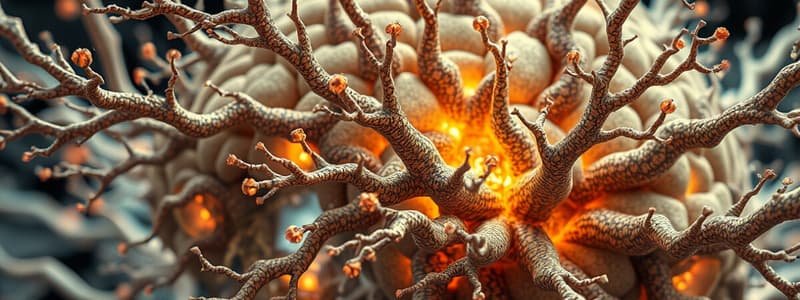Podcast
Questions and Answers
Which type of receptor is primarily responsible for fast excitatory synaptic transmission in the central nervous system?
Which type of receptor is primarily responsible for fast excitatory synaptic transmission in the central nervous system?
- Metabotropic receptors
- NMDA receptors
- AMPARs (correct)
- Kainate receptors
What is required for NMDA receptor activation?
What is required for NMDA receptor activation?
- Only the influx of sodium
- Only glutamate
- Glutamate, glycine, and depolarisation (correct)
- Glycine and a high concentration of calcium
What role does calcium flux through NMDA receptors play in the neuron?
What role does calcium flux through NMDA receptors play in the neuron?
- It initiates apoptosis in neurons.
- It promotes synaptic plasticity linked to learning and memory. (correct)
- It reduces synaptic transmission.
- It inhibits the activation of AMPARs.
What is the primary feature of NMDA receptor kinetics compared to AMPA receptors?
What is the primary feature of NMDA receptor kinetics compared to AMPA receptors?
What is the relationship between synaptic activity and AMPAR regulation?
What is the relationship between synaptic activity and AMPAR regulation?
What is the primary component of the late phase of excitatory postsynaptic currents (EPSCs)?
What is the primary component of the late phase of excitatory postsynaptic currents (EPSCs)?
In terms of location, where can NMDA receptors be found?
In terms of location, where can NMDA receptors be found?
What is a key physiological role of dendritic spines on neurons?
What is a key physiological role of dendritic spines on neurons?
What is the primary consequence of CaMKaII activation during LTP?
What is the primary consequence of CaMKaII activation during LTP?
Which of the following is necessary for the induction of LTP at CA3-CA1 synapses?
Which of the following is necessary for the induction of LTP at CA3-CA1 synapses?
Which receptor's activation is essential for Ca2+-mediated effects in LTP?
Which receptor's activation is essential for Ca2+-mediated effects in LTP?
What is the end result of LTP in synaptic function?
What is the end result of LTP in synaptic function?
What role does CaMKaII's self-phosphorylation play in LTP?
What role does CaMKaII's self-phosphorylation play in LTP?
What mechanism underlies long-term depression (LTD) in synaptic plasticity?
What mechanism underlies long-term depression (LTD) in synaptic plasticity?
Which process is enhanced as a result of LTP at the synapse?
Which process is enhanced as a result of LTP at the synapse?
What is the significance of the neurochemical cascade in the induction of LTP?
What is the significance of the neurochemical cascade in the induction of LTP?
What is the primary function of AMPARs in the context of synaptic transmission?
What is the primary function of AMPARs in the context of synaptic transmission?
Which of the following correctly describes the activation of Group I mGluRs?
Which of the following correctly describes the activation of Group I mGluRs?
What role does calcium play in synaptic plasticity?
What role does calcium play in synaptic plasticity?
Which receptor has a slower opening and closing time compared to AMPARs?
Which receptor has a slower opening and closing time compared to AMPARs?
What potential outcome is expected from the binding of glutamate to Group I mGluRs?
What potential outcome is expected from the binding of glutamate to Group I mGluRs?
What is the relationship between NMDARs and AMPARs in terms of their synaptic roles?
What is the relationship between NMDARs and AMPARs in terms of their synaptic roles?
How many distinct functional groups are there among the subtypes of Group I mGluRs?
How many distinct functional groups are there among the subtypes of Group I mGluRs?
What happens when PIP2 is cleaved by PLC in the context of Group I mGluR activation?
What happens when PIP2 is cleaved by PLC in the context of Group I mGluR activation?
What is the primary mechanism underlying changes in synaptic strength?
What is the primary mechanism underlying changes in synaptic strength?
Which region of the brain is crucial for memory and learning due to its role in long-term potentiation?
Which region of the brain is crucial for memory and learning due to its role in long-term potentiation?
Which type of receptors are directly involved in initiating long-term potentiation in the hippocampus?
Which type of receptors are directly involved in initiating long-term potentiation in the hippocampus?
What occurs prior to NMDA receptor activation during synaptic transmission?
What occurs prior to NMDA receptor activation during synaptic transmission?
What is the consequence of long-term depression (LTD) on synaptic connections?
What is the consequence of long-term depression (LTD) on synaptic connections?
How can synaptic plasticity be measured in the hippocampus?
How can synaptic plasticity be measured in the hippocampus?
Which of the following describes a feature of AMPA receptors in the context of synaptic activity?
Which of the following describes a feature of AMPA receptors in the context of synaptic activity?
What best describes synaptic plasticity's role in neuronal circuits?
What best describes synaptic plasticity's role in neuronal circuits?
How does the activation time of mGluRs compare to that of iGluRs?
How does the activation time of mGluRs compare to that of iGluRs?
What is the primary role of mGluRs in neuronal activity?
What is the primary role of mGluRs in neuronal activity?
According to Hebbian theory, what is a key characteristic of a Hebbian synapse?
According to Hebbian theory, what is a key characteristic of a Hebbian synapse?
What does long-term potentiation (LTP) primarily facilitate in the brain?
What does long-term potentiation (LTP) primarily facilitate in the brain?
Which components are associated with functions exhibiting Hebbian behavior?
Which components are associated with functions exhibiting Hebbian behavior?
Which statement about NMDA and AMPA receptors is correct?
Which statement about NMDA and AMPA receptors is correct?
What best describes the impact of neural plasticity on behavior?
What best describes the impact of neural plasticity on behavior?
Which process is associated with the growth of new neurons in response to experience?
Which process is associated with the growth of new neurons in response to experience?
Flashcards are hidden until you start studying
Study Notes
Dendritic Spines
- Dendrites of excitatory neurons are often adorned with spines that receive synaptic inputs from presynaptic axons.
- Spines exhibit dynamic plasticity, enabling them to change in response to various stimuli.
Glutamate Receptors
- Ionotropic receptors (iGluRs) facilitate fast synaptic transmission with millisecond responses, allowing ions to flow in and out of neurons.
- Metabotropic receptors (mGluRs) mediate slower synaptic transmission and activate messenger cascades, with responses taking seconds.
Ionotropic Glutamate Receptors (iGluRs)
- Primarily include AMPA receptors (AMPARs), NMDA receptors (NMDARs), and Kainate receptors.
- AMPARs and NMDARs are often co-localized at glutamatergic synapses, mediating rapid chemical synaptic transmission, while also being present extrasynaptically and in autoreceptor roles.
AMPA Receptors (AMPARs)
- Open and close quickly, responsible for most fast excitatory transmission in the CNS.
- They enable the influx of sodium (Na+), potassium (K+), and some calcium (Ca2+).
- Structure consists of four subunits, GluA1, GluA2, GluA3, and GluA4, regulated by second messenger cascades involving various kinases.
NMDA Receptors (NMDARs)
- Named after the specific agonist NMDA, NMDARs are tetramers with a choice of three subunits.
- Characterized by slow activation and deactivation kinetics, they require glutamate and glycine to activate.
- Allow entry of calcium, sodium, and potassium, functioning as ligand and voltage-sensitive receptors.
Coincidence Detectors
- NMDARs necessitate glutamate, glycine, and a depolarized membrane potential to activate.
- Play a critical role in synaptic plasticity, particularly important for learning and memory due to calcium flux.
Kinetics of NMDA & AMPA Receptors
- Non-NMDA receptors generate an early and large synaptic potential, while NMDA receptors contribute to a late component of excitatory postsynaptic currents (EPSCs).
- AMPARs activate rapidly, whereas NMDARs respond slowly, allowing for unique timing in synaptic transmission.
Long-Term Potentiation (LTP) and Depression (LTD)
- LTP involves AMPAR insertion into the postsynaptic membrane, enhancing synaptic strength.
- LTD involves the removal of AMPARs and is associated with the shrinkage of dendritic spines.
- Both processes are thought to underlie mechanisms of learning and memory.
Metabotropic Glutamate Receptors (mGluRs)
- Comprised of single polypeptide chains with seven transmembrane domains, mGluRs engage in G-protein-mediated signaling cascades.
- Activation pathways include the cleavage of PIP2 leading to the release of calcium from internal stores.
Significance of mGluRs
- mGluR activation results in slower, longer-lasting effects compared to iGluRs.
- Effects are pervasive throughout neurons, modulating synaptic activity by changing presynaptic channel openings.
Hebbian Synapses
- Governed by the principle that "neurons that fire together, wire together," contributing to memory storage through synaptic strength enhancement.
- NMDARs act as coincidence detectors, crucial for Hebbian learning mechanisms.
Synaptic Plasticity and Changes
- The nervous system exhibits plasticity, allowing for structural changes during learning, including the efficiency of synapses.
- Mechanisms such as LTP and LTD are prevalent in the brain, with various forms identified across distinct synapses.
Role of the Hippocampus
- The hippocampus is critically involved in memory and learning, demonstrating LTP at multiple sites, particularly between CA3 and CA1 regions.
- NMDA-dependent LTP within the hippocampus illustrates the importance of calcium influx and increased synaptic efficacy during stimulation.
Studying That Suits You
Use AI to generate personalized quizzes and flashcards to suit your learning preferences.




